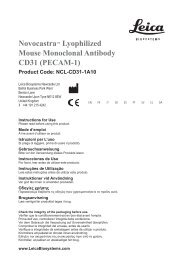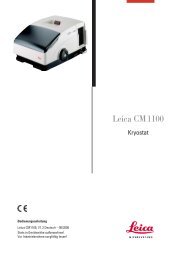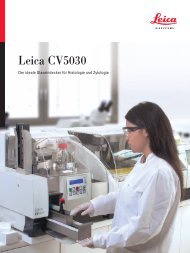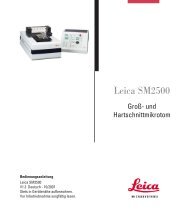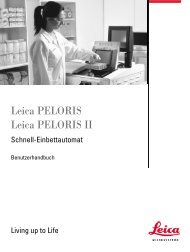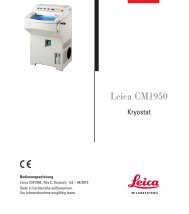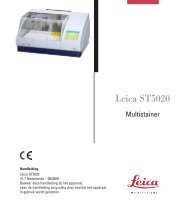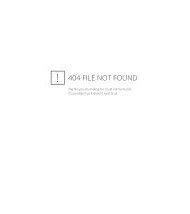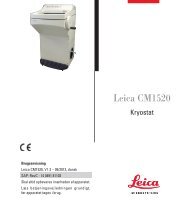Info - Leica Biosystems
Info - Leica Biosystems
Info - Leica Biosystems
You also want an ePaper? Increase the reach of your titles
YUMPU automatically turns print PDFs into web optimized ePapers that Google loves.
• Specimens, before and after fixation, and all materials exposed to them, should be handled as if capable of transmitting infection and<br />
disposed of with proper precautions2 . Never pipette reagents by mouth and avoid contacting the skin and mucous membranes with<br />
reagents or specimens. If reagents or specimens come in contact with sensitive areas, wash with copious amounts of water. Seek<br />
medical advice.<br />
• Consult Federal, State or local regulations for disposal of any potentially toxic components.<br />
• Minimize microbial contamination of reagents or an increase in non-specific staining may occur.<br />
• Retrieval, incubation times or temperatures other than those specified may give erroneous results. Any such change must be<br />
validated by the user.<br />
Instructions for Use<br />
Thyroid Transcription Factor-1 (SPT24) primary antibody was developed for use on the automated Bond system in combination with<br />
Bond Polymer Refine Detection. The recommended staining protocol for Thyroid Transcription Factor-1 (SPT24) primary antibody is IHC<br />
Protocol F. Heat induced epitope retrieval is recommended using Bond Epitope Retrieval Solution 1 for 20 minutes.<br />
Results Expected<br />
Normal Tissues<br />
Clone SPT24 detected the thyroid transcription factor-1 protein in the nucleus of follicular epithelial cells of the thyroid (13/13), type II<br />
pneumocytes and Clara cells of the lung (9/9). Some reactivity was also noted in glial cells in cerebrum (3/3).<br />
Clone SPT24 did not stain TTF-1 in a variety of other normal tissues (n=140) including colon (0/12), brain (0/8), placenta (0/4), kidney<br />
(0/6), prostate (0/4), testis (0/4), heart (0/4), spleen (0/4), cervix (0/5), lymph node (0/2), thymus (0/13), tongue (0/1), endometrium (0/2),<br />
skeletal muscle (0/4), tonsil (0/4), salivary gland (0/4), myometrium (0/1), umbilical cord (0/1), ureter (0/1), bronchus (0/1), ovary (0/4),<br />
fallopian tube (0/1), liver (0/4), breast (0/4), esophagus (0/4), stomach (0/4), spinal cord (0/1), eye (0/1), pancreas (0/4), ileum (0/4),<br />
cecum (0/1), rectum (0/1), adrenal (0/4), mesothelium (0/1), parathyroid (0/1), peripheral nerve (0/3), pituitary (0/3), bone marrow (0/3),<br />
uterus (0/3) and skin (0/4).<br />
Abnormal Tissues<br />
Clone SPT24 detected the thyroid transcription factor-1 protein in the nucleus of 26/32 lung adenocarcinoma, 4/7 lung small cell<br />
carcinoma, 2/3 lung bronchioalveolar carcinoma, 6/6 thyroid papillary carcinoma, 4/4 thyroid medullary carcinoma, 3/3 thyroid follicular<br />
carcinoma, 1/1 thyroid follicular adenoma, 1/1 Hashimoto’s thyroiditis, 19/56 thymoma, 1/1 desmoplastic small round cell tumor, 3/38<br />
moderately differentiated colon adenocarcinoma and 1/1 rectal carcinoma.<br />
Clone SPT24 did not stain lung squamous cell carcinoma (0/18), lung large cell carcinoma (0/5), poorly differentiated colon<br />
adenocarcinoma (0/4), well differentiated colon adenocarcinoma (0/3), ungraded colon adenocarcinoma (0/3), mesothelioma (0/5),<br />
small bowel carcinoid (0/4), thymus atypical carcinoid (1/5), metastatic thymic tumor (0/1), breast tumor (0/6), liver tumor (0/8), kidney<br />
renal cell carcinoma (0/5), kidney transitional cell carcinoma (0/1), ovary thecoma (0/1), ovary granulosa cell tumor (0/1), ovary juvenile<br />
granulosa (0/1), ovary serous carcinoma (0/3), ovary mucinous carcinoma (0/2), ovary germ cell tumor (0/1), ovary clear cell carcinoma<br />
(0/1), stomach adenocarcinoma (0/4), pancreas adenocarcinoma (0/2), pancreas papillary mucinous carcinoma (0/1), pancreas islet<br />
cell tumor (0/1), pancreas glucagonoma (0/1), testis seminoma (0/3), testis mixed germ cell tumor (0/1), testis embryonal carcinoma<br />
(0/1), brain astrocytoma (0/1), brain choroid plexus papilloma (0/1), melanoma (0/3), skin basal cell carcinoma (0/1), skin squamous<br />
cell carcinoma (0/2), penis squamous cell carcinoma (0/2), esophagus squamous cell carcinoma (0/2), larynx squamous cell carcinoma<br />
(0/1), tongue squamous cell carcinoma (0/2), cervix squamous carcinoma (0/1), small bowel carcinoma (0/1), GIST (0/1), synovial<br />
sarcoma (0/1), leiomyosarcoma (0/1), Ewing’s sarcoma (0/1), spindle cell rhabdomyosarcoma (0/1), omental fibrous tumor (0/1), bladder<br />
transitional cell carcinoma (0/2), bladder small cell carcinoma (0/1), large B-cell lymphoma (0/1), adrenal oncocytoma (0/2), adrenal<br />
adenoma (0/1), ganglioneuroma (0/1), prostate adenocarcinoma (0/1), benign prostatic hyperplasia (0/1), endometrial stromal sarcoma<br />
(0/1), endometrial adenocarcinoma (0/1), endometrial clear cell carcinoma (0/1), pheochromocytoma (0/1), paraganglioma (0/1) and<br />
cervix tumor (0/2).<br />
Thyroid Transcription Factor-1 (SPT24) is recommended for use in the identification of TTF-1 in normal and neoplastic tissues<br />
and for use in diagnosis as part of a panel of antibodies.<br />
Product Specific Limitations<br />
Thyroid Transcription Factor-1 (SPT24) has been optimized at <strong>Leica</strong> <strong>Biosystems</strong> for use with Bond Polymer Refine Detection and<br />
Bond ancillary reagents. Users who deviate from recommended test procedures must accept responsibility for interpretation of patient<br />
results under these circumstances. The protocol times may vary, due to variation in tissue fixation and the effectiveness of antigen<br />
enhancement, and must be determined empirically. Negative reagent controls should be used when optimizing retrieval conditions and<br />
protocol times.<br />
Troubleshooting<br />
Refer to reference 3 for remedial action.<br />
Contact your local distributor or the regional office of <strong>Leica</strong> <strong>Biosystems</strong> to report unusual staining.<br />
Further <strong>Info</strong>rmation<br />
Further information on immunostaining with Bond reagents, under the headings Principle of the Procedure, Materials Required,<br />
Specimen Preparation, Quality Control, Assay Verification, Interpretation of Staining, Key to Symbols on Labels, and General Limitations<br />
can be found in “Using Bond Reagents” in your Bond user documentation.<br />
PA0364<br />
Page 3



